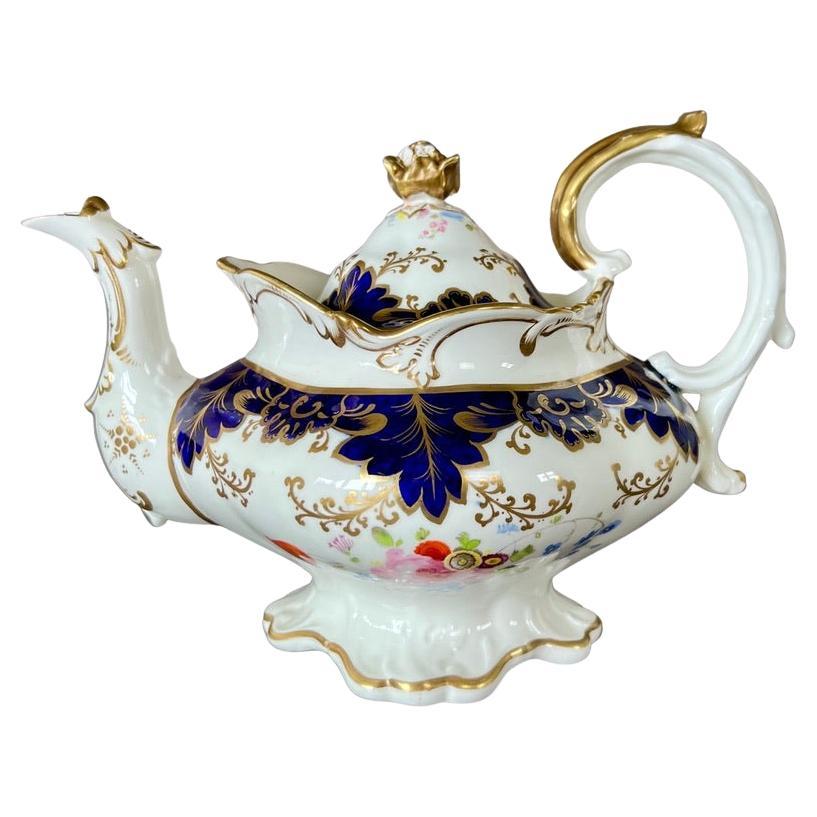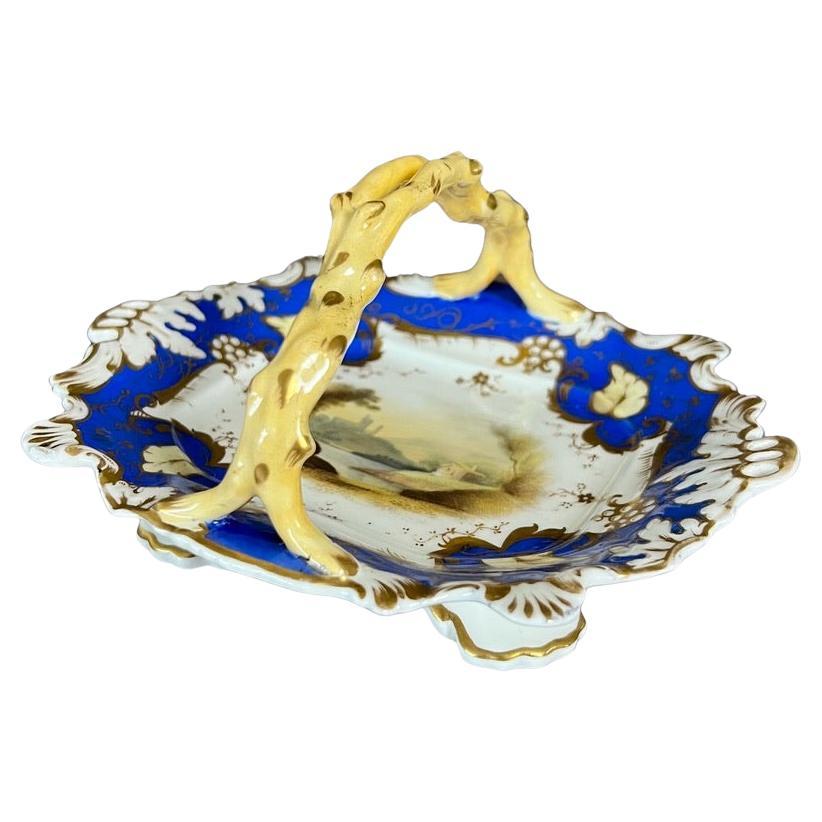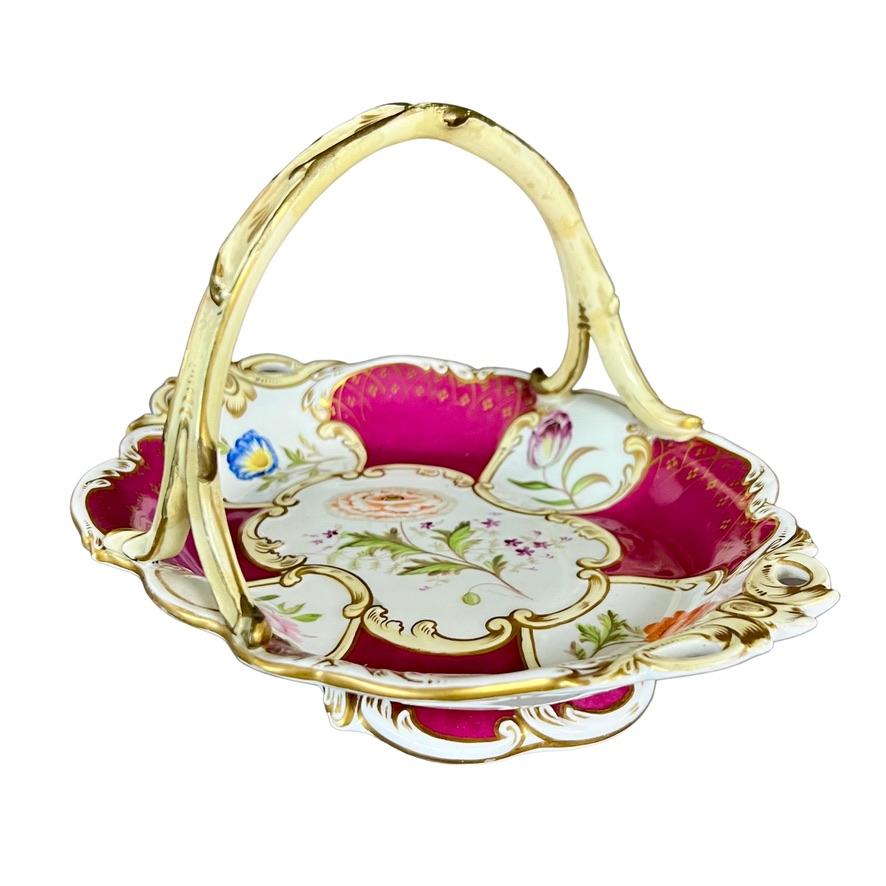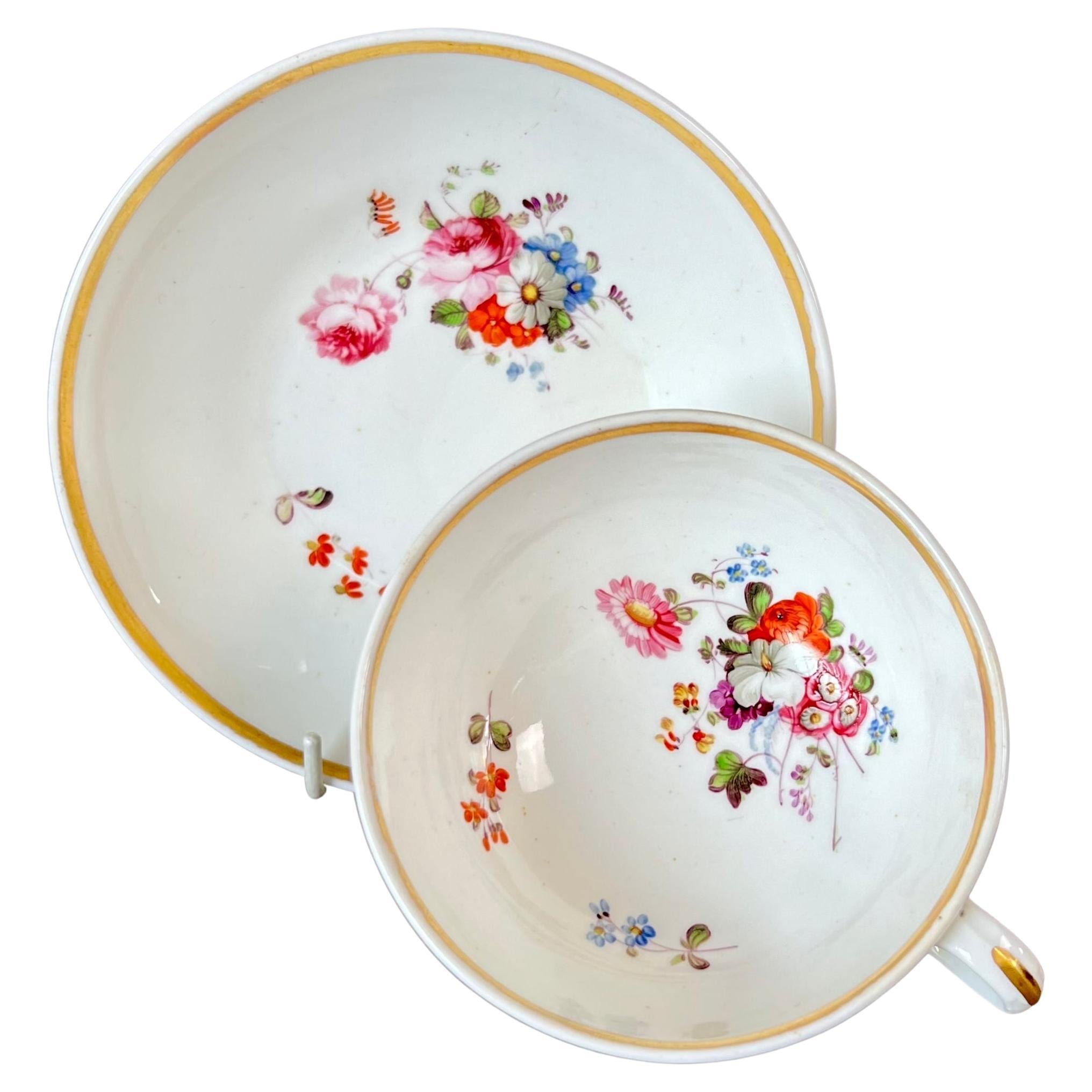Items Similar to Samuel Alcock Porcelain Coffee Cup, Orange Imari Flowers, Rococo Revival ca 1830
Want more images or videos?
Request additional images or videos from the seller
1 of 14
Samuel Alcock Porcelain Coffee Cup, Orange Imari Flowers, Rococo Revival ca 1830
About the Item
This is a beautiful coffee cup and saucer made by Samuel Alcock around 1830, which was the Rococo Revival era. The set is decorated with a bold Imari pattern and has a "ring-moulded" shape.
Samuel Alcock was one of the many potters in Staffordshire such as Spode, Coalport, H&R Daniel and many others during the 1830s and 1840s. He was perhaps not the most well-known of potters but produced very high quality wares and original designs, often standing out for their bright choice of colours and beautiful shapes. The Alcock factory is not well documented so although they had a huge output, items are often mis-identified and we don't know much about the production process of artists, even though the wares have a very high quality that equals that of the more well known factories.
The Rococo style was originally a style of the 18th Century. After the Baroque style, which was highly symmetrical and well-designed as it aimed to express the perfection of God, the Rococo style was a reaction that expressed the unpredictability and flow of nature. "Rococo" is derived from the French word "rocaille", which stands for a mass of pebbles that are self-organised in a completely unpredictable mess, for instance on the beach or in the mountains. Rococo moved away from the stranglehold that religion had on the arts: it was capricious, asymmetrical, charming and worldly. As Europe got mired in various wars between Germany, France and Britain, the general style got much more austere again and people embraced neo-classicism. But in the 1830s and 1840s, the seemingly unlimited fortunes of the Industrial Revolution sparked a revival of Rococo, once again creating natural shapes that are not always symmetrical and don't particularly make rational sense.
This coffee cup can be identified as Rococo Revival because of its generous bell-shape and its interesting moulding; you can see the little rings around the the rims, and the handle which, if you look carefully, looks like a bent twig. In spite of this Rococo Revival shape the pattern is more traditional: a bright, rather wildly painted Imari pattern in cobalt blue, gilt and orange, with big oriental flowers.
The items are unmarked, which is common for this era.
Condition report: The set is in very good antique condition without any damage, repairs or crazing. There is wear to the gilt and the pattern, as visible in the pictures; however the set still looks bright.
Antique British porcelain is never perfect. Kilns were fired on coal in the 1800s, and this meant that china from that period can have some firing specks from flying particles. British makers were also known for their experimentation, and sometimes this resulted in technically imperfect results. Due to the shrinkage in the kiln, items can have small firing lines or develop crazing over time, which should not be seen as damage but as an imperfection of the maker's recipes, probably unknown at the time of making. Items have often been used for many years and can have normal signs of wear, and gilt can have signs of slight disintegration even if never handled. I will reflect any damage, repairs, obvious stress marks, crazing or heavy wear in the item description but some minor scratches, nicks, stains and gilt disintegration can be normal for vintage items and need to be taken into account.
There is widespread confusion on the internet about the difference between chips and nicks, or hairlines and cracks. I will reflect any damage as truthfully as I can, i.e. a nick is a tiny bit of damage smaller than 1mm and a chip is something you can easily see with the eye; a glazing line is a break in the glazing only; hairline is extremely tight and/or superficial and not picked up by the finger; and a crack is obvious both to the eye and the finger.
Dimensions: (diameter) cup 8.2cm (3.25"), saucer 14.2cm (5.6").
- Creator:Samuel Alcock & Co. (Maker)
- Dimensions:Height: 1 in (2.54 cm)Diameter: 1 in (2.54 cm)
- Sold As:Set of 2
- Style:Rococo Revival (Of the Period)
- Materials and Techniques:
- Place of Origin:
- Period:
- Date of Manufacture:circa 1830
- Condition:Wear consistent with age and use. In very good antique condition, no damage, repairs or crazing; wear to the gilt and the pattern.
- Seller Location:London, GB
- Reference Number:
About the Seller
5.0
Platinum Seller
These expertly vetted sellers are 1stDibs' most experienced sellers and are rated highest by our customers.
Established in 2016
1stDibs seller since 2019
208 sales on 1stDibs
Typical response time: <1 hour
- ShippingRetrieving quote...Ships From: London, United Kingdom
- Return PolicyA return for this item may be initiated within 14 days of delivery.
More From This SellerView All
- Samuel Alcock Porcelain Teapot, Blue, Gilt and Flowers, Rococo Revival ca 1837By Samuel Alcock & Co.Located in London, GBA teapot with cover in the “rustic bean” shape, cobalt blue ground with gilt acanthus motif and finely painted flower posies on the belly of the teapot Pattern 5782 Year: ca 1837 Si...Category
Antique 1830s English Rococo Revival Tea Sets
MaterialsPorcelain
- Samuel Alcock Teacup Trio, Beige with Hand Painted Flowers, Rococo Revival 1841By Samuel Alcock & Co.Located in London, GBThis is a beautiful "true trio" made by Samuel Alcock in or shortly after 1841. The trio is decorated in a warm beige ground with a gilt pattern and beautiful flowers in the centre of each item. In the late 18th and early 19th Century cups and saucers...Category
Antique 1840s English Rococo Revival Tea Sets
MaterialsPorcelain
- Samuel Alcock Porcelain Basket, French Blue, Landscape, Rococo Revival ca 1830By Samuel Alcock & Co.Located in London, GBA small porcelain basket in Rococo Revival style with scroll and shell moulded borders, pierced handles on both ends, a pale yellow twig handle, a French blue ground with pale yellow foliage and a fine landscape painting in the centre. This would make a perfect gift as a trinket dish - these baskets were often used to collect visting cards from guests. Pattern unknown Year: ca 1830 Size: 17.5cm (6.8”) long, 9cm (3.5”) tall Condition: excellent The Samuel Alcock factory was operative in Staffordshire between 1822 and 1856, after which it was bought by Sir James Duke and Nephews. The factory started as a partnership between the young Samuel Alcock and the older Ralph Stevenson, who provided the factory and capital. Alcock quickly took the factory to great heights, building one of the biggest factories of its time. Alcock jumped on the new Rococo Revival fashion and served a huge new middle class market. The reason we now don't hear much about Samuel Alcock porcelain...Category
Antique 1830s English Rococo Revival Decorative Baskets
MaterialsPorcelain
- Samuel Alcock Matched Solitaire Porcelain Tea Set, Pink with Flowers, ca 1836By Samuel Alcock & Co.Located in London, GBA matched solitaire tea set consisting of a teapot with cover, a sucrier with cover, a milk jug and a matched trio consisting of a teacup, a coffee cup and a saucer. With pink ground...Category
Antique 1830s English Rococo Revival Tea Sets
MaterialsPorcelain
- Samuel Alcock Porcelain Basket, Rococo Revival, Maroon, Flower Reserves, ca 1835By Samuel Alcock & Co.Located in London, GBA maroon ground basket in Rococo Revival style with pierced pale yellow ends, a twig handle and five flower reserves with single flowers. Pattern 2/5610 Year: ca 1835 Size: 22.5cm (8.75”) long, 13cm (5”) tall Condition: handle has been repaired, see last picture; some rubbing This basket forms part of the Murray Pollinger Collection of Samuel Alcock Porcelain...Category
Antique 1830s English Rococo Revival Decorative Baskets
MaterialsPorcelain
- Samuel Alcock Porcelain Teacup, White with Flower Sprays, ca 1823By Samuel Alcock & Co.Located in London, GBA teacup and saucer in the “half orange” shape, white with simple gilt rim and beautiful hand painted flower sprays Pattern unknown but similar to 1082 Year: ca 1823 Size: cup diameter 10cm (4”), saucer diameter 14.2cm (5.5”) Condition: excellent, some rubbing to gilt There are several items available in this design, please see group image and ask for more info if interested. The Samuel Alcock factory was operative in Staffordshire between 1822 and 1856, after which it was bought by Sir James Duke and Nephews. The factory started as a partnership between the young Samuel Alcock and the older Ralph Stevenson, who provided the factory and capital. Alcock quickly took the factory to great heights, building one of the biggest factories of its time. Alcock jumped on the new Rococo Revival fashion and served a huge new middle class market. The reason we now don't hear much about Samuel Alcock porcelain...Category
Antique 1820s English Regency Tea Sets
MaterialsPorcelain
You May Also Like
- 2 Antique 19th Century English Samuel Alcock Blue Gold Floral Cups & SaucersBy Samuel Alcock & Co.Located in Dayton, OH"Four piece set of antique mid 19th century Samuel Alcock porcelain tea / coffee cups and saucers featuring turquoise blue with florals and gold gilding. Samuel Alcock (1799–1848) was a leading pottery manufacturer who operated as Samuel Alcock & Co in Burslem, Staffordshire from 1828 to 1859. They were especially noted for ""picture jugs"" modelled and moulded in relief in various ceramic materials, a popular type of object in these years. Samuel Alcock & Co. Alcock was born in Kingsley, Staffordshire. He was the youngest of the nine children of Thomas (1746–1816) and Catherine Alcock (1756–1838). Though from a farming background, he developed an interest in commerce after working with his uncle Joseph Locker, a grocer, tea dealer, provision dealer, chandler and banker of the Market Square, Hanley. His introduction to pottery came when he embarked upon a partnership with Ralph Stevenson of Cobridge, Staffordshire. In 1828, Alcock developed his own business and began work on the Hill Top site in Cobridge. By the 1830s Stevenson employed 600 people at his works. In 1839 he completed work on a large factory, built in the Venetian style, on the junction of Westport Road and Greenhead Street. In November of that year a party to celebrate the opening was held at the George Hotel...Category
Antique 19th Century Victorian Tea Sets
MaterialsPorcelain
- A fine English porcelain Punch Bowl attributed to Samuel Alcock c.1830By Samuel Alcock & Co.Located in Exeter, GBA fine English porcelain Punch Bowl attributed to Samuel Alcock c.1830. Superbly painted summer flowers to the centre interior of the bowl...Category
Antique 19th Century Porcelain
MaterialsPorcelain
- Hand Painted Gilt Porcelain Tea, Coffee Cup with Desert PlateLocated in North Hollywood, CAFine gilt original porcelain coffee or tea cup with saucer and desert plate. Enjoy the start to your day with the classical sophistication of this fine p...Category
Late 20th Century French Bohemian Porcelain
MaterialsPorcelain
- Tulip Coffee Cup in Gilded Paris Porcelain by Flamen-FleuryBy Old ParisLocated in Paris, FRTulip-shaped cup with its saucer in Old Paris Porcelain. Hand-painted pieces with lovely purple and white shades, in the shape of a tulip flower. Very delicate piece with a butterfly...Category
Antique Early 19th Century French Restauration Porcelain
MaterialsPorcelain
- Meissen Porcelain Pink Roses Coffee Service and Embossed Decorations '11 Cups'By Meissen PorcelainLocated in Prato, TuscanyWe kindly suggest you read the whole description, because with it we try to give you detailed technical and historical information to guarantee the authenticity of our objects. Rare Meissen porcelain coffee service in Biedermeier style; the set consists of a teapot, a sugar bowl, a milk jug, and 11 cups with plate; the various pieces are made of fine hand-painted hard white porcelain with the "Pink Roses" decoration enriched on all items with sumptuous unpainted relief decorations. Unlike the simple and quite common "Pink Roses", this model is very rare, prestigious, and sought after, therefore even more expensive; in fact, the objects with this relief decoration, much more particular and detailed than others, were fired three times, while those with only the "Pink Roses" decoration only twice. Moreover, the execution of this ornamental motif with delicate and graceful flowers was entrusted only to the most experienced and skilled painters, those in possession of the prestigious diploma obtained at the "School of Drawing of Meissen" established since 1764. The knobs of the teapot and sugar bowl represent two harmonious and graceful rosebuds, also handmade; the edges of the cups and saucers are scalloped and finished with pure gold as well as the other decorations of the teapot and sugar bowl. All pieces bear the original Meissen trademark (two crossed swords) and from the enclosed list it can be stated with certainty that our service was produced between 1934 and 1944; moreover, on the objects the model is handwritten (61/106), this wording makes the artifacts even more precious and appreciated as they preserve all the characteristics of the author's calligraphy. Meissen porcelain was created in the castle of Albrechtsburg, in Meissen, a small town in Saxony near Dresden, in 1710, at the behest of Augustus the Strong (1670-1733), Prince-Elector of Saxony and King of Poland, who wanted to start production after the studies and experiments of his alchemist Bottger. Bottger discovered the formula for porcelain, in fact at that time, only the Chinese and Japanese had the recipe to create this wonderful material; Meissen was, therefore, the first porcelain produced in Europe! Bottger never revealed his formula to anyone, only a certain stage was known to the workers; we do not know, even today, in what proportions the different components are mixed; this is the great secret that allowed the famous brand to be considered the best in the world, Meissen porcelain is given the nickname of "white gold"! Through the years, Meissen has perfected its hard-paste products with high-temperature firing during its glazing. Meissen's porcelain patterns have been copied by many other manufacturers around the world such as Royal Copenhagen, Dresden, Herend, and many others, but Meissen's porcelain glaze maintains its quality over time and is superior to all (plates will not scratch with prolonged use of cutlery!). This is why even old Meissen...Category
Mid-20th Century German Biedermeier Porcelain
MaterialsPorcelain
- Fabergé Porcelain Tea, Coffee Cups Set of Four in a Velvet CaseBy Modern FabergéLocated in North Hollywood, CAFine porcelain set of four Fabergé original porcelain coffee or tea cups, service for four. Enjoy the start to your day with the classical sophistication only from Faberge. These s...Category
Late 20th Century French Empire Porcelain
MaterialsPorcelain
Recently Viewed
View AllMore Ways To Browse
Coffee Cup Set
Antique Tea Cans
Flowers Used For Tea
Antique Silver Rococo
Antique Tea Sign
Coffee And Tea Cups
Traditional French Dining Set
Antique Glass Tea Cups
Antique Cup And Saucer Sets
Stained Glass Artist
Coffe Set Silver French
Tea Cup Hand Painted
French Rococo Porcelain
Antique Tea Cup Saucer
Antique Tea Cup Cups And Saucers
Antique Tea Cups Cups And Saucers
Antique Tea Cups Saucers
Antique Porcelain Tea Cup





